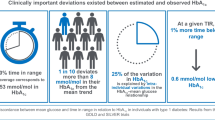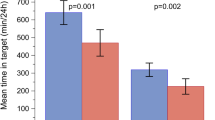Abstract
Background
HbA1c levels are infl uenced by the glycemic control of previous 2–3 months. Sometimes patients have surprisingly low HbA1c in spite of many correctly measured high blood glucose values, which is diffi cult to explain. As glucose sensors give an objective picture based on glucose readings several times per minute over 24 hours, we used the area under the curve (AUC) of such subcutaneous glucose profi les to evaluate their relationship with HbA1c.
Methods
Thirty-two patients were randomized into two study arms, one open and the other blinded. Both arms had 8 pump users and 8 patients with multiple daily injections (MDI). After three months the two arms crossed over. Both study arms wore a continuous glucose monitoring system (CGMS) for 3 days every 2 weeks. HbA1c was determined before and after each 3-month study period.
Results
There was no relationship between HbA1c and s.c. glucose AUC or between HbA1c and the number of peaks >15.0 mmol/L when all CGMS profi les during the 6 months were taken together. Children on MDI showed a positive relationship between HbA1c and AUC (P<0.01) as well as the number of peaks (P<0.01). Children with a negative relationship between HbA1c and AUC generally had fewer fluctuations in blood glucose values, whereas children with a positive relationship had wide fluctuations.
Conclusions
Although there was no relationship between s.c. glucose AUC and HbA1c, the results indicate that wide blood glucose fluctuations may be related to high HbA1c values. Therefore, complications and therapeutic interventions should aim at reducing such fluctuations.
Similar content being viewed by others
References
The effect of intensive treatment of diabetes on the development and progression of long-term complications in insulin-dependent diabetes mellitus. The Diabetes Control and Complications Trial Research Group. N Engl J Med 1993;329:977–986.
Bojestig M, Arnqvist HJ, Hermansson G, Karlberg BE, Ludvigsson J. Declining incidence of nephropathy in insulindependent diabetes mellitus. N Engl J 1994;330:15–18.
Nordwall M, Bojestig M, Arnqvist HJ, Ludvigsson J. Declining incidence of severe retinopathy and persisting decrease of nephropathy in an unselected population of Type 1 diabetes-the Linkö** Diabetes Complications Study. Diabetologia 2004;47:1266–1272.
Hovind P, Tarnow L, Rossing K, Rossing P, Eising S, Larsen N, et al. Decreasing incidence of severe diabetic microangiopathy in type 1 diabetes. Diabetes Care 2003;26:1258–1264.
Mortensen HB, Hougaard P. Comparison of metabolic control in a cross-sectional study of 2,873 children and adolescents with IDDM from 18 countries. The Hvidøre Study Group on Childhood Diabetes. Diabetes Care 1997;20:714–720.
Danne T, Mortensen HB, Hougaard P, Lynggaard H, Aanstoot HJ, Chiarelli F, et al. Persistent differences among centers over 3 years in glycemic control and hypoglycemia in a study of 3,805 children and adolescents with type 1 diabetes from the Hvidore Study Group. Diabetes Care 2001;24:1342–1347.
Lindblad B, Nordin G, SWEDIABKIDS. The Swedish childhood diabetes registry. 0–18 years. Experiences with HbA1c from the first years. Pediatr Diabetes 2004;5(Suppl 1):15.
Danne T, Mortensen HB, Hougaard P, Lynggaard H, Aanstoot HJ, Chiarelli F, et al. Persistent differences among centers over 3 years in glycemic control and hypoglycemia in a study of 3,805 children and adolescents with type 1 diabetes from the Hvidore Study Group. Diabetes Care 2001;24:1342–1347.
Gabbay KH, Hasty K, Breslow JL, Ellison RC, Bunn HF, Gallop PM. Glycosylated hemoglobins and long-term blood glucose control in diabetes mellitus. J Clin Endocrinol Metab 1977;44:859–864.
Mayer TK, Freedman ZR. Protein glycosylation in diabetes mellitus: a review of laboratory measurements and of their clinical utility. Clin Chim Acta 1983;127:147–184.
Davie SJ, Gould BJ, Yudkin JS. Effect of vitamin C on glycosylation of proteins. Diabetes 1992;41:167–173.
van Heyningen C, Hanid TK, Hopkinson I. Glycosylated haemoglobin by affi nity chromatography in diabetic and nondiabetic children. Ann Clin Biochem 1986;23:425–428.
Kilpatrick ES, Dominiczak MH, Small M. The effects of ageing on glycation and the interpretation of glycaemic control in Type 2 diabetes. QJM 1996;89:307–312.
Lowrey CH, Lyness SJ, Soeldner JS. The effect of hemoglobin ligands on the kinetics of human hemoglobin A1c formation. J Biol Chem 1985;260:11611–11618.
Kilpatrick ES, Maylor PW, Keevil BG. Biological variation of glycated hemoglobin. Implications for diabetes screening and monitoring. Diabetes Care 1998;21:261–264.
Gross TM, Bode BW, Einhorn D, Kayne DM, Reed JH, White NH, et al. Performance evaluation of the MiniMed continuous glucose monitoring system during patient home use. Diabetes Technol Ther 2000;2:49–56.
Mastrototaro J. The MiniMed Continuous Glucose Monitoring System (CGMS). J Pediatr Endocrinol Metab 1999;12Suppl 3:751–758.
Boyne MS, Silver DM, Kaplan J, Saudek CD. Timing of changes in interstitial and venous blood glucose measured with a continuous subcutaneous glucose sensor. Diabetes 2003;52:2790–2794.
Ludvigsson J, Hanas R. Continuous subcutaneous glucose monitoring improved metabolic control in pediatric patients with type 1 diabetes: a controlled crossover study. Pediatrics 2003;111:933–938.
Kullberg CE, Bergström A, Dinesen B, Larsson L, Little RR, Goldstein DE, et al. Comparisons of studies on diabetic complications hampered by differences in GHb measurements. Diabetes Care 1996;19:726–729.
Arnqvist H, Wallensteen M, Jeppson JO. Standards for longterm measures of blood sugar are established. Lakartidningen 1997;94:4789–4790.
Kovatchev BP, Cox DJ, Gonder-Frederick LA, Young-Hyman D, Schlundt D, Clarke W. Assessment of risk for severe hypoglycemia among adults with IDDM: validation of the low blood glucose index. Diabetes Care 1998;21:1870–1875.
Hermansson G, Ludvigsson J, Larsson Y. Home blood glucose monitoring in diabetic children and adolescents. A 3-year feasibility study. Acta Paediatr Scand 1986;75:98–105.
The DCCT Research group. Diabetes Control and Complications Trial (DCCT): results of feasibility study. The DCCT Research Group. Diabetes Care 1987;10:1–19.
McCarter RJ, Hempe JM, Gomez R, Chalew SA. Biological variation in HbA1c predicts risk of retinopathy and nephropathy in type 1 diabetes. Diabetes Care 2004;27:1259–1264.
Deiss D, Hartmann R, Hoeffe J, Kordonouri O. Assessment of glycemic control by continuous glucose monitoring system in 50 children with type 1 diabetes starting on insulin pump therapy. Pediatr Diabetes 2004;5:117–121.
Alemzadeh R, Loppnow C, Parton E, Kirby M. Glucose sensor evaluation of glycemic instability in pediatric type 1 diabetes mellitus. Diabetes Technol Ther 2003;5:167–173.
Fiallo-Scharer R; Diabetes Research in Children Network Study Group. Eight-point glucose testing versus the continuous glucose monitoring system in evaluation of glycemic control in type 1 diabetes. J Clin Endocrinol Metab 2005;90:3387–3391.
Sachedina N, Pickup JC. Performance assessment of the Medtronic-MiniMed Continuous Glucose Monitoring System and its use for measurement of glycaemic control in Type 1 diabetic subjects. Diabet Med 2003;20:1012–1015.
Kilpatrick ES, Rigby AS, Atkin SL. The effect of glucose variability on the risk of microvascular complications in type 1 diabetes. Diabetes Care 2006;29:1486–1490.
Snieder H, Sawtell PA, Ross L, Walker J, Spector TD, Leslie RD. HbA(1c) levels are genetically determined even in type 1 diabetes: evidence from healthy and diabetic twins. Diabetes 2001;50:2858–2863.
Hempe JM, Gomez R, McCarter RJ Jr, Chalew SA. High and low hemoglobin glycation phenotypes in type 1 diabetes: a challenge for interpretation of glycemic control. J Diabetes Complications 2002;16:313–320.
Polhill TS, Saad S, Poronnik P, Fulcher GR, Pollock CA. Short-term peaks in glucose promote renal fi brogenesis independently of total glucose exposure. Am J Physiol Am J Physiol Renal Physiol 2004;287:F268–273.
The relationship of glycemic exposure (HbA1c) to the risk of development and progression of retinopathy in the diabetes control and complications trial. Diabetes 1995;44:968–983.
McCarter RJ, Hempe JM, Chalew SA. Mean blood glucose and biological variation have greater infl uence on HbA1c levels than glucose instability: an analysis of data from the Diabetes Control and Complications Trial. Diabetes Care 2006;29:352–355.
Derr R, Garrett E, Stacy GA, Saudek CD. Is HbA1c affected by glycemic instability? Diabetes Care 2003;26:2728–2733.
Pickup JC, Kidd J, Burmiston S, Yemane N. Determinants of glycaemic control in type 1 diabetes during intensifi ed therapy with multiple daily insulin injections or continuous subcutaneous insulin infusion: importance of blood glucose variability. Diabetes Metab Res Rev 2006;22:232–237.
Author information
Authors and Affiliations
Corresponding author
Rights and permissions
About this article
Cite this article
Samuelsson, U., Hanas, R., Whiss, P.A. et al. Do high blood glucose peaks contribute to higher HbA1c? Results from repeated continuous glucose measurements in children. World J Pediatr 4, 215–221 (2008). https://doi.org/10.1007/s12519-008-0040-8
Received:
Accepted:
Published:
Issue Date:
DOI: https://doi.org/10.1007/s12519-008-0040-8




